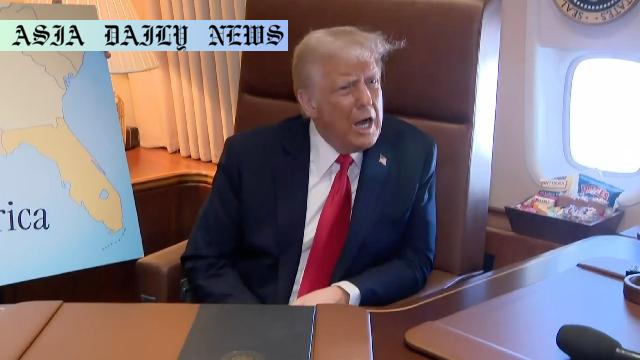US Steel: Trump insists no majority stake for foreign owners, citing patriotic revival and benefiting from import tariffs.

US Steel: A National Treasure Under Threat
US Steel has long been seen as symbolic of American industrial power and ingenuity. Its contributions to the nation’s economy and defense efforts have cemented its place in the annals of US history. However, a combination of poor management, obsolete practices, and unfavorable policies caused the company’s decline in recent decades. President Donald Trump recently vowed to protect US Steel from foreign acquisition, citing its strategic and symbolic value to the nation.
Trump’s Position: No Foreign Majority Stake
Speaking aboard Air Force One, Trump emphasized that ‘nobody can have a majority stake for US Steel,’ explicitly targeting Nippon Steel’s attempts to acquire full control of the company. Trump’s remarks underscore his administration’s determination to prevent foreign entities from controlling strategic American assets. Nippon Steel announced plans in 2023 to acquire all of US Steel’s shares, aiming to make it a wholly owned subsidiary. However, this proposal has faced resistance, with Trump signaling that he supports his predecessor’s decision to block such acquisitions.
Tariffs as a Financial Tool
To bolster US Steel’s finances, Trump has championed additional tariffs on steel and aluminum imports. By introducing a 25% tariff on these imports, Trump believes that domestic producers, including US Steel, will benefit from reduced foreign competition. This strategy ties directly into his broader economic policy aimed at bringing manufacturing jobs back to America and reviving industries that once thrived domestically.
A Controversial Strategy
While Trump’s move to safeguard US Steel is applauded by many proponents of economic nationalism, it has also drawn criticism. Opponents argue that tariffs could lead to higher prices for consumers and retaliatory measures from international trading partners, potentially igniting a trade war. Meanwhile, Nippon Steel has maintained a neutral stance on Trump’s comments, expressing its willingness to meet with the President to discuss the matter. The Japanese firm has underscored that a formal meeting must first be scheduled, adding that Chairman and CEO Hashimoto Eiji is prepared to travel to Washington for discussions.
The Revival Plan
Beyond policies aimed at restricting foreign ownership, Trump’s vision for US Steel involves reviving the company to its historic glory. He referenced US Steel’s heydays when it was ‘the greatest company in the world’ as a benchmark for its potential future. However, achieving such a transformation requires addressing foundational issues, including modernizing infrastructure, adopting innovative technologies, and ensuring sustainable growth.
A Broader Nationalistic Strategy
Trump’s comments and policies related to US Steel are part of a larger narrative of economic patriotism. By focusing on domestic production and reducing reliance on foreign entities, he aims to strengthen the American economy and preserve jobs. Critics, however, remain skeptical about the sustainability and efficacy of such policies, citing the complexities of global trade and economic interdependence.
The Future of US Steel
The future of US Steel hinges on the outcomes of ongoing negotiations, strategic investments, and government support. While Trump’s interventions aim to protect the company from foreign control and stimulate growth, it is imperative for US Steel to adapt to modern industry trends. Collaborative approaches leveraging support from the government, private investors, and international partnerships will likely play a pivotal role in shaping the company’s trajectory.
Commentary
Protecting Strategic Assets in a Global Economy
President Trump’s unwavering stance on preventing foreign majority ownership of US Steel underscores the significance of protecting strategic national assets. In a globalized economy, where cross-border investments and acquisitions are commonplace, maintaining control over key industries has become a priority for policymakers seeking to safeguard national interests. US Steel is more than just a company—it symbolizes the strength and resilience of American manufacturing.
The Role of Government in Industrial Revival
One of the most compelling aspects of this issue is the role of government in revitalizing struggling industries. By imposing tariffs on steel and aluminum imports, Trump aims to create a level playing field for domestic producers like US Steel. While this approach has its critics, it reflects a larger vision of fostering economic self-reliance and reducing dependency on foreign entities.
The Crucial Balance Between Protectionism and Global Trade
However, this strategy is not without its challenges. Critics argue that protectionist policies like tariffs could lead to unintended consequences, such as inflation and strained international relationships. As the global economy becomes increasingly interconnected, striking a balance between protecting domestic interests and fostering international cooperation remains a complex undertaking that requires careful consideration.
A Path Forward for US Steel
For US Steel, the path forward will likely involve a combination of government support, innovative strategies, and responsible management. Beyond international politics, the company must navigate internal challenges to regain its prominence in the steel industry. Investments in technology, sustainability, and workforce development will be critical for ensuring long-term success.
Conclusion: A Defining Moment
The ongoing discourse surrounding US Steel serves as a defining moment for the intersection of policy, economics, and national identity. Whether Trump’s approach proves successful remains to be seen, but it undoubtedly highlights the importance of prioritizing strategic industries in an ever-evolving global landscape.


